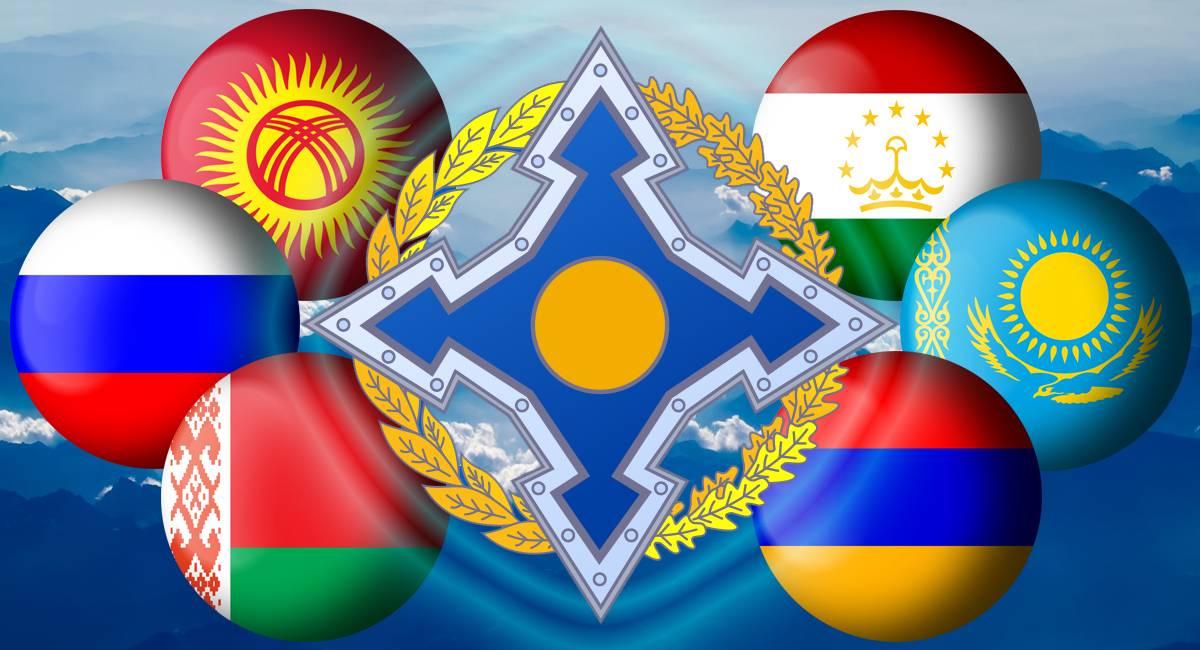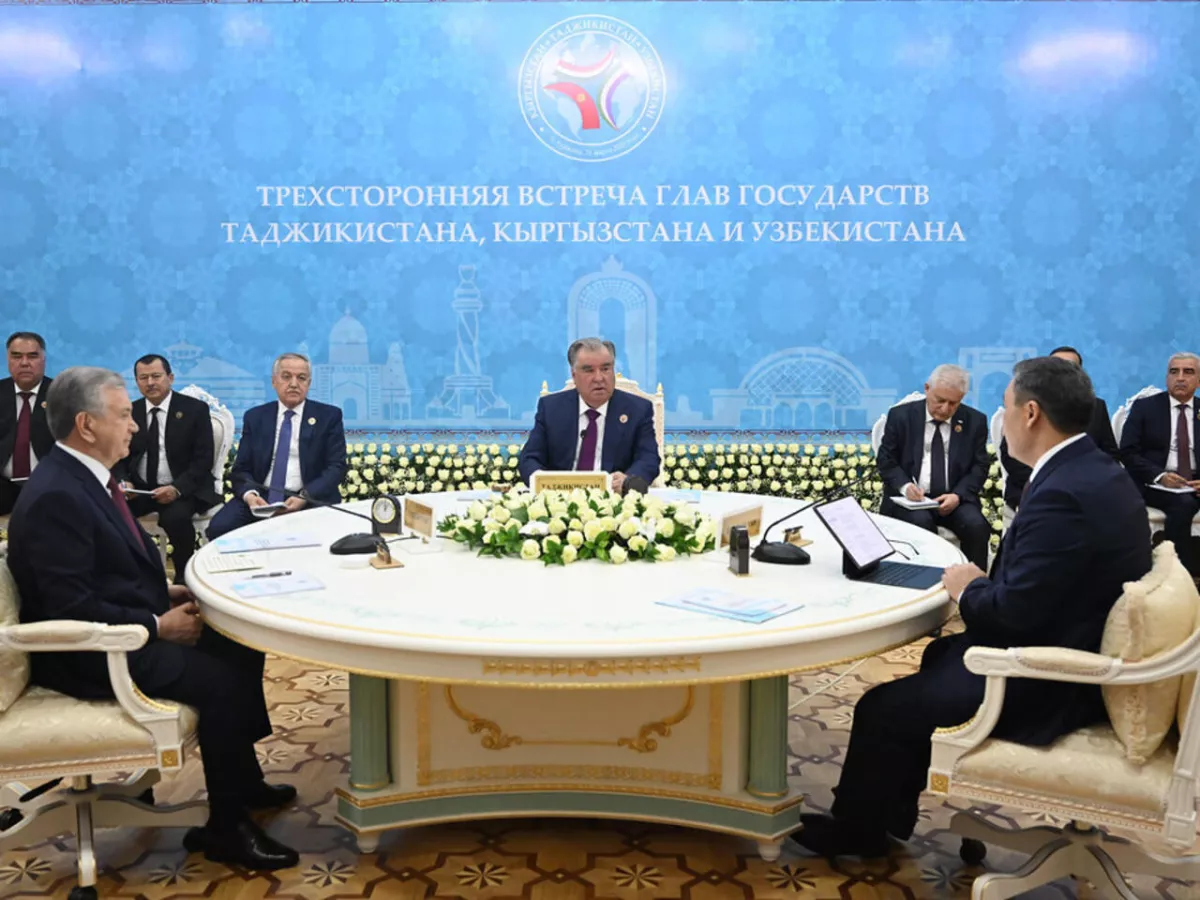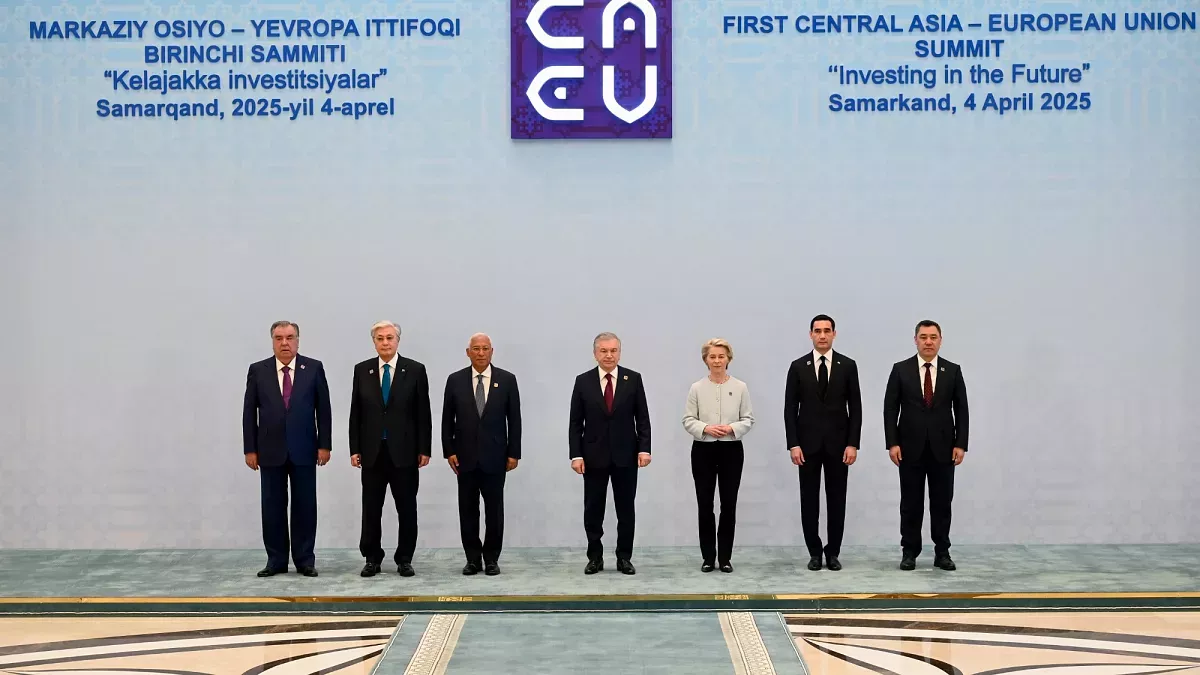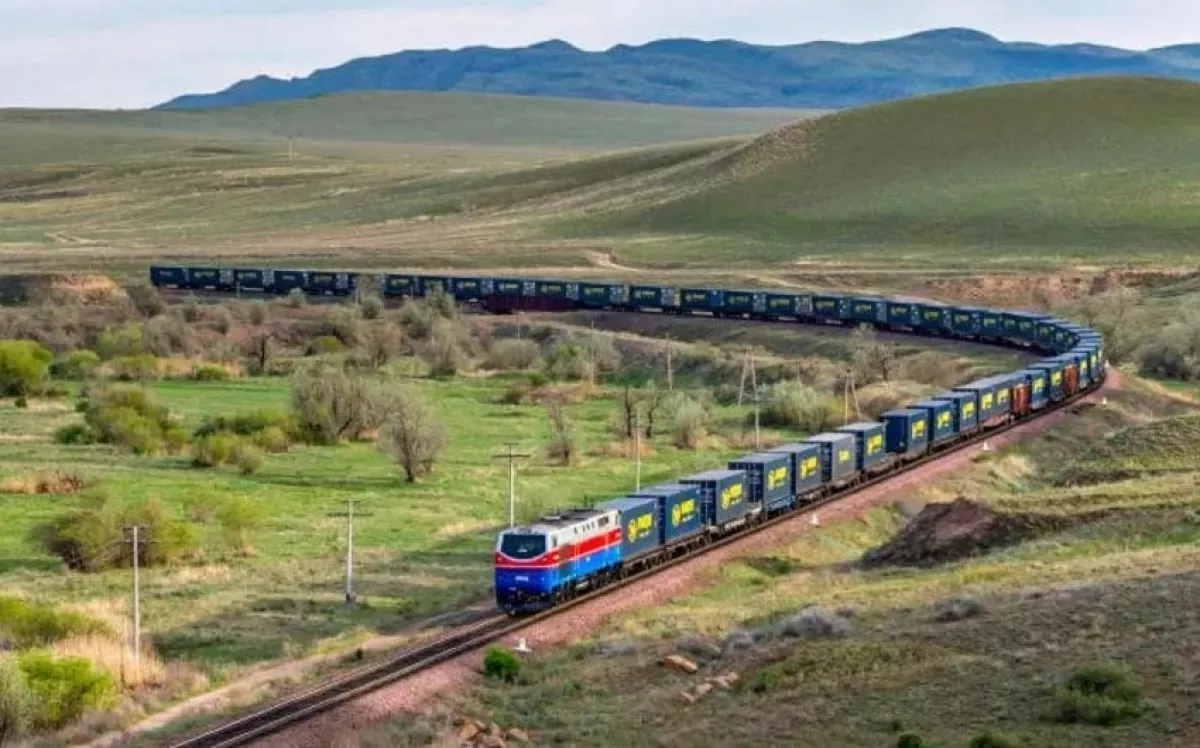Summits in Central Asia and the collapse of Western interventionist policy From conflict to cooperation
On March 31, the first-ever trilateral summit of the Presidents of Tajikistan, Kyrgyzstan, and Uzbekistan took place. They signed an agreement on the alignment of their borders, resolving disputed issues.
Central Asia continues to build its own model of development and interaction, rejecting unwanted mentors and judges. Recently, European Union countries have ceased campaigns against the region's states, thus highlighting their bias and impotence in attempting to impose their will. The week concluded with a summit between the Central Asian countries and the EU, which reflected this new policy. However, its results also demonstrated its shortcomings, particularly the need for a more pragmatic approach in the EU's relations with the countries of the South Caucasus.
The superpowers are gone — peace has arrived
The importance of the meeting in Khujand cannot be overstated. The heads of the Central Asian republics addressed issues that had been sources of periodic tensions and even armed clashes. The last large-scale confrontation occurred at the border between Kyrgyzstan and Tajikistan in September 2022, resulting in the deaths of over one hundred people.
Interestingly, these problems persisted and even grew during the time when the world powers were allegedly actively assisting the Central Asian countries. Some of them spoke of human rights and peacekeeping, while others emphasized traditional values and historical ties with the region. A number of significant global players had a broad presence in the region since the 1990s, while border disputes continued, and none of them helped resolve them.
At first glance, they seemed to be concerned about stability and peace in the region, as Central Asian countries served as a rear base for the U.S. and NATO's advance into Afghanistan and their long-term military presence there, amidst the growing resistance movement. By the way, perhaps some have forgotten, but back then NATO and the U.S. were in the region alongside Russia, which, while speaking of the dangers of the Taliban, justified its hegemony or condominium (so to speak, joint dominance) with the West in Central Asia through these stories. However, Russia, in addition to its long-standing agreement with the West, seemed to have its own reasons to promote peace and stability in Central Asia — after all, Moscow built the Collective Security Treaty Organization (CSTO) around this region, relying on the "Afghan threat" narrative!
But in reality, the West has done nothing to help stabilize the Central Asian countries, merely insisting on how everything is supposedly wrong in their view. USAID and other Western structures have invested in creating and developing practically any kind of "opposition" in these countries, regardless of its direction or recklessness. Russia criticized the region on different grounds, but for years it merely observed the infighting within the CSTO, between its own allies!

It was only after global powers began losing interest in Afghanistan and, consequently, became less involved in the affairs of Central Asia that the countries of the region started finding their own solutions to the problems. Since the late 2010s, the countries of the region have successfully overcome former disagreements, rejecting military means to resolve conflicts. As a result, for example, against the backdrop of escalating confrontation in Europe, Central Asian countries have cleared minefields along their borders. Over the past few years, trade turnover between Uzbekistan, Kyrgyzstan, and Tajikistan has increased tenfold, with half of it coming from cross-border trade!
This was followed by breakthrough steps in the demarcation and delimitation of borders. Although Bishkek and Dushanbe were the first among the countries in the region to start border negotiations — back in 2002 — the tension in the region, created and sustained by the superpowers, along with the endless intrigues of these global players, did not facilitate quick success. By 2020, Kyrgyzstan and Tajikistan had agreed on only about 60% of the border, and local conflicts regularly flared up in disputed areas. The process accelerated after 2022, when global players shifted their focus to other regions and issues.
In this context, in just two years, Kyrgyzstan and Tajikistan resolved more issues than in the previous twenty, and on March 13, Kyrgyzstan and Tajikistan signed a treaty on their mutual border. Uzbekistan had already agreed on its borders with these two countries earlier, which was the result of President Shavkat Mirziyoyev's foreign policy. His confident foreign policy demonstrated that all the talk about a "geopolitical vacuum" in the region after the gradual withdrawal of occupying forces from Afghanistan was meaningless. The departure of external powers did not create any vacuum but rather facilitated the resolution of the region's problems by its countries and peoples.
In other words, the current summit appears not to be a fleeting rapprochement between the three countries for a number of reasons but rather continues the trends of recent years. Moreover, the current event in Khujand was not limited to border issues; these were resolved alongside other topics. The Khujand Declaration on Eternal Friendship adopted at the summit calls for the expansion of trilateral cooperation. Just before the summit began, the Presidents of Kyrgyzstan, Sadyr Japarov, and Tajikistan, Emomali Rahmon, not only held talks on cooperation in trade, economics, and energy but also launched a new interstate power transmission line as part of the regional CASA-1000 project. This project integrates the energy systems of the two countries to supply electricity not only to Afghanistan but also further to Pakistan. In this way, the Central Asian region is linking up with the neighboring giant region of South Asia. Uzbekistan’s President Mirziyoyev also made it clear that for him, the settlement of borders is a reason to seek closer ties, not the other way around. He proposed creating a trilateral trade platform and modernizing customs posts at the borders.

The full significance of the meeting in Khujand can be assessed in light of parallel news from Europe, where, while the Central Asian countries were negotiating the resolution of key disagreements, completely different sentiments prevailed. Almost simultaneously with the news from Khujand, it was revealed that three Eastern European countries—Lithuania, Poland, and Latvia—had withdrawn from the Convention on the Prohibition of Anti-Personnel Mines (long known as inhumane weapons, which disproportionately affect civilians) and were urgently mining their borders. As the Lithuanian Minister of Defense, Dovilė Šakalienė, explained, this was part of implementing plans for the "renewal and expansion of the concept of counter-mobility"!
In search of Central Asian friends
Seeing how the Central Asian countries, by rejecting intrusive external advice, were resolving their own issues, Western countries have also recently changed their attitude toward them. Moreover, after the final breakdown of long-standing Russian-Western relations, Europeans became much more active in seeking friendships with Russia's neighbors. In 2023, German President Frank-Walter Steinmeier visited Kazakhstan and Kyrgyzstan, Italian President Sergio Mattarella visited Uzbekistan, and French President Macron visited both Kazakhstan and Uzbekistan. Last autumn, for the first time in 14 years, German Chancellor Scholz paid an official visit to Uzbekistan and Kazakhstan, where he met with the leaders of all five Central Asian republics. Unlike previous visits, Western politicians during these trips were more careful with their language, although, as we know, even when visiting, many of them do not behave as guests. To add to this, Germany once effectively denied the Uzbek Minister of Internal Affairs medical treatment and even allowed him to be persecuted during his stay in a Berlin hospital. The same Germany, along with the entire EU, had imposed sanctions on Uzbek politicians for many years.
Of course, the interest of EU countries in Central Asia is understandable: Macron was openly looking for uranium, while Scholz sought oil and gas. The former has had no noticeable success so far, but the Germans are indeed replacing part of their Russian oil supplies with Kazakh imports, making Kazakhstan the third-largest oil supplier to Germany after Norway and the United States. Over the past seven years, trade between the five Central Asian republics and the EU has quadrupled, reaching €54 billion.
However, the most important change is that there has been a reduction in Western paternalism and mentoring in current interactions. EU members are now actively seeking mutual understanding rather than lecturing their counterparts. They promise money and resources, instead of reprimanding their partners. Radical liberal activists from "human rights organizations" were furious last year when it emerged that the EU signed a large-scale trade and cooperation agreement with Kyrgyzstan, despite the country adopting a law—following Georgia—that requires organizations receiving foreign funding to publicly declare it. This, let us remind, is not just a logical demand but a standard practice in the US, which helps inform citizens of potential conflicts of interest. However, according to "human rights activists," non-Western citizens should not have such basic information. Nevertheless, the loud protests from "human rights activists" had no effect, and the EU refrained from repeating the "Georgian scenario" of recent months in Kyrgyzstan.

The EU's shift away from radical interventionism was also evident at the first Central Asia-EU summit held on April 3-4 in Samarkand. The leaders of Kyrgyzstan, Tajikistan, Uzbekistan, Kazakhstan, Turkmenistan, and senior EU officials participated in the event. The EU now approaches relations with these countries in a less dogmatic manner, although remnants of the previous zeal still persist, as seen in a comment from a senior EU official to the British Guardian. According to him, "We are not going there to preach. But the more we have a dialogue and engagement and interaction, the more we believe that we can change and improve all the things that concern us." In other words, while the Europeans have not yet abandoned their desire to intervene in the affairs of other countries, some movement in this direction is already noticeable. And well-known, opportunistic "human rights" organizations like Human Rights Watch and Amnesty International once again strongly criticized the EU at the end of the week for its refusal to make pressure on the region’s countries over human rights compliance a key element of its Central Asia policy.
The EU needs not only Central Asia but also the South Caucasus
Following the Samarkand summit, it was announced that a strategic partnership would be established between the EU and these five countries, focusing on four areas: transit, "critical raw materials," "clean energy," and information communications. The first two are the most important and also raise questions about their implementation. The issue is not only the insufficient funds offered by Brussels but also the remnants of EU dogmatism.
Thus, the European Union plans to continue investing in the Trans-Caspian Transport Corridor. This corridor will not only halve the distance between the EU and China, whose importance for Europe is growing despite the ritual criticism of Beijing from liberal European elites, but it will also allow the EU to access those "critical raw materials" from Central Asia and neighboring regions, thus replacing Russian supplies — the second area of "strategic partnership." Last year, the EU allocated €10 billion to develop this route, a significant but clearly insufficient sum, given the vital issues at stake regarding the EU’s access to markets and resources. In addition, Ursula von der Leyen announced the allocation of €12 billion to the region for implementing the Global Gateway projects — an initiative to develop a global network of infrastructure projects, openly promoted by Brussels as a counter to China’s Belt and Road Initiative. However, these are not large amounts, especially when burdened with political obligations!

The main question, however, is how the EU plans to ensure transit to Asia and secure resources from there via the Caspian route without the participation of Azerbaijan and Georgia? After all, no alternative routes exist — in the foreseeable future, the EU cannot bypass Azerbaijan and Georgia from the north (via Russia) or from the south (via Iran). In this situation, Brussels officials should have long ago considered revisiting their policy, not only towards Central Asia but also the South Caucasus. To do so, they simply need to return to the lost sense of common sense in politics over the years of pseudo-liberal triumphalism and build a pragmatic, rather than dogmatic, policy in the region.
More specifically, in the case of Georgia, this would mean refraining from interfering in its internal affairs and creating opportunities for its integration with the EU on principles of equality, as well as respecting the dignity, values, and traditions of the Georgian people. In the case of Azerbaijan, this would require the EU and its members to abandon intrigues with revanchist circles in Armenia, winding down the intelligence mission on Azerbaijan’s borders, and halting attempts to revise the peace treaty project agreed upon by Baku and Yerevan. However, sooner or later, the development of contacts with Central Asian countries and the objective increase in the EU's need for ties with Central Asia will force the Europeans to think about strengthening relations with the South Caucasus as well.
There is no alternative to this, geography and economics leave them no other choice. But Brussels and other European capitals are hesitating, and the price of this normalization will continue to rise. After all, the EU needs Central Asia and the South Caucasus far more than the countries of these regions need the EU. The countries of Central Asia and the South Caucasus have achieved their current successes not thanks to external benefactors from the West or the East, as global players sometimes openly conspired against them and offered them destructive ideas. They achieved everything solely through their own efforts, and in this sense, the Central Asian republics, Azerbaijan, and Georgia are on the same path.








